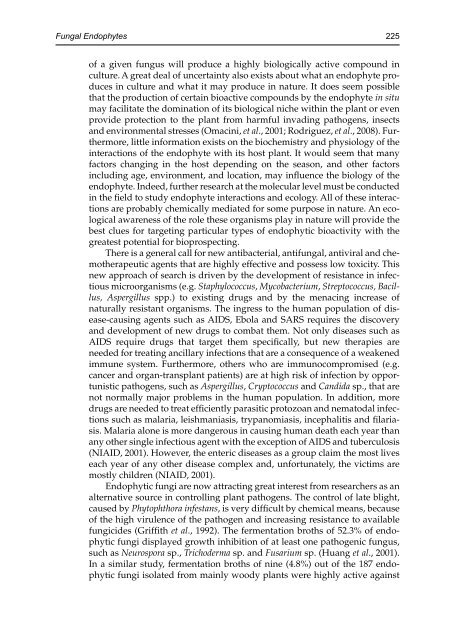natural-products-in-plant-pest-management
natural-products-in-plant-pest-management
natural-products-in-plant-pest-management
Create successful ePaper yourself
Turn your PDF publications into a flip-book with our unique Google optimized e-Paper software.
Fungal Endophytes 225of a given fungus will produce a highly biologically active compound <strong>in</strong>culture. A great deal of uncerta<strong>in</strong>ty also exists about what an endophyte produces<strong>in</strong> culture and what it may produce <strong>in</strong> nature. It does seem possiblethat the production of certa<strong>in</strong> bioactive compounds by the endophyte <strong>in</strong> situmay facilitate the dom<strong>in</strong>ation of its biological niche with<strong>in</strong> the <strong>plant</strong> or evenprovide protection to the <strong>plant</strong> from harmful <strong>in</strong>vad<strong>in</strong>g pathogens, <strong>in</strong>sectsand environmental stresses (Omac<strong>in</strong>i, et al., 2001; Rodriguez, et al., 2008). Furthermore,little <strong>in</strong>formation exists on the biochemistry and physiology of the<strong>in</strong>teractions of the endophyte with its host <strong>plant</strong>. It would seem that manyfactors chang<strong>in</strong>g <strong>in</strong> the host depend<strong>in</strong>g on the season, and other factors<strong>in</strong>clud<strong>in</strong>g age, environment, and location, may <strong>in</strong>fluence the biology of theendophyte. Indeed, further research at the molecular level must be conducted<strong>in</strong> the field to study endophyte <strong>in</strong>teractions and ecology. All of these <strong>in</strong>teractionsare probably chemically mediated for some purpose <strong>in</strong> nature. An ecologicalawareness of the role these organisms play <strong>in</strong> nature will provide thebest clues for target<strong>in</strong>g particular types of endophytic bioactivity with thegreatest potential for bioprospect<strong>in</strong>g.There is a general call for new antibacterial, antifungal, antiviral and chemotherapeuticagents that are highly effective and possess low toxicity. Thisnew approach of search is driven by the development of resistance <strong>in</strong> <strong>in</strong>fectiousmicroorganisms (e.g. Staphylococcus, Mycobacterium, Streptococcus, Bacillus,Aspergillus spp.) to exist<strong>in</strong>g drugs and by the menac<strong>in</strong>g <strong>in</strong>crease of<strong>natural</strong>ly resistant organisms. The <strong>in</strong>gress to the human population of disease-caus<strong>in</strong>gagents such as AIDS, Ebola and SARS requires the discoveryand development of new drugs to combat them. Not only diseases such asAIDS require drugs that target them specifically, but new therapies areneeded for treat<strong>in</strong>g ancillary <strong>in</strong>fections that are a consequence of a weakenedimmune system. Furthermore, others who are immunocompromised (e.g.cancer and organ-trans<strong>plant</strong> patients) are at high risk of <strong>in</strong>fection by opportunisticpathogens, such as Aspergillus, Cryptococcus and Candida sp., that arenot normally major problems <strong>in</strong> the human population. In addition, moredrugs are needed to treat efficiently parasitic protozoan and nematodal <strong>in</strong>fectionssuch as malaria, leishmaniasis, trypanomiasis, <strong>in</strong>cephalitis and filariasis.Malaria alone is more dangerous <strong>in</strong> caus<strong>in</strong>g human death each year thanany other s<strong>in</strong>gle <strong>in</strong>fectious agent with the exception of AIDS and tuberculosis(NIAID, 2001). However, the enteric diseases as a group claim the most liveseach year of any other disease complex and, unfortunately, the victims aremostly children (NIAID, 2001).Endophytic fungi are now attract<strong>in</strong>g great <strong>in</strong>terest from researchers as analternative source <strong>in</strong> controll<strong>in</strong>g <strong>plant</strong> pathogens. The control of late blight,caused by Phytophthora <strong>in</strong>festans, is very difficult by chemical means, becauseof the high virulence of the pathogen and <strong>in</strong>creas<strong>in</strong>g resistance to availablefungicides (Griffith et al., 1992). The fermentation broths of 52.3% of endophyticfungi displayed growth <strong>in</strong>hibition of at least one pathogenic fungus,such as Neurospora sp., Trichoderma sp. and Fusarium sp. (Huang et al., 2001).In a similar study, fermentation broths of n<strong>in</strong>e (4.8%) out of the 187 endophyticfungi isolated from ma<strong>in</strong>ly woody <strong>plant</strong>s were highly active aga<strong>in</strong>st


